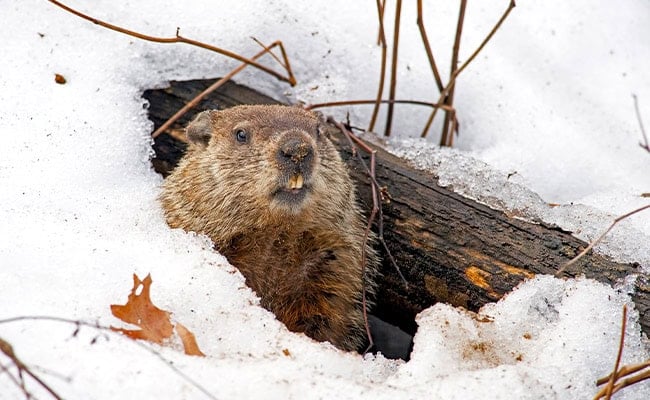8 Natural Ways To Get Rid of Groundhogs
Good news! There are many ways to safely deter these pesky marmots using common items around your home and garden. No toxic chemicals!

Are you wondering how to get rid of groundhogs without harming them? Here are some top groundhog repellents and tips:
About Groundhogs
Groundhogs, also known as woodchucks, “whistle pigs,” or marmots, are rodents that can do a lot of damage to your lawns and gardens. Because they are excellent diggers (their dens can be extensive tunnel systems containing chambers, hallways, and multiple exits), they can weaken the soil, resulting in damage to foundations, barns, and farm equipment, as well as cause possible injuries to livestock. And since groundhogs are herbivores, they enjoy making a meal on the plants in your garden, so all that hard work you put into it can be decimated in a single afternoon. They certainly make a nuisance of themselves.
So what can you do? If you don’t own a dog, or you’re not comfortable trapping and releasing* (or don’t have the means to), consult our list of 8 effective, natural remedies to help keep them out, below. These ideas won’t harm the environment, family pets, or the groundhogs themselves.
A few Key Things To Know
First, it’s important to know that prevention is very important when it comes to any rodent infestations. Try to identify and remove what they’re attracted to in your yard. For example, a food source like fruit from apple trees. Harvest your garden and pick up any fallen fruit often. Also, consider a covered compost bin—especially if your compost piles have sweet fruit like melons, a groundhog’s favorite. You’ll also want to reduce any woodpiles on your property.
Before you start tackling your groundhog problem, be sure that is what you are really up against. Some good indicators that a groundhog is present are:
- A hole 10 to 12 inches wide in the ground or under a shed, foundation or deck, with mounds of dirt around it.
- Teeth of claw marks.
- Damaged plants with good sized bites taken out of them.

Additionally, knowing the groundhog’s habits is key. The time when they emerge from their post-winter dens will differ depending on where you live (despite what you hear, most groundhogs are hibernating on February 2 and are not popping up to see their shadows), and they’re active during the day. Spring is when they start mating so they’ll be very active during this time.
8 Natural Ways To Get Rid of Groundhogs
1) Epsom Salts
Groundhogs hate the taste of Epsom salts. Sprinkle them around the perimeter of your garden and near burrow entrances and exits. You may also try placing a tin pie plate filled with the salts near the plants. (Replace after a rain.) If you are consistent, you will keep the groundhogs away.
If you are concerned about putting the salt near your garden, don’t worry. This isn’t table salt, and it may actually good for your plants.
2) Castor Oil
Groundhogs hate the smell of castor oil. To make your own homemade groundhog repellent, mix one half cup of castor oil with two cups of water and spray it in and around the burrow holes. But only apply it when you know they’re not there, otherwise, they’ll just stay burrowed. (You’ll have to keep vigil to see when they head out to find food.)

3) Human Hair Clippings
Clippings from your local barber or hairdresser may also prevent groundhogs well because they dislike the scent of humans. Sprinkle clippings around areas where the groundhog frequents. Or to avoid it blowing away in the wind, place clippings in a fine mesh bag and secure it to a stake near the groundhog’s dwelling.
4) Blood Meal Fertilizer
Blood meal is a great organic fertilizer for your plants, while also repelling pesty groundhogs (and squirrels). Sprinkle blood meal around the perimeter of your garden, concentrating on entry points or plants that have been a common target. The strong odor is a natural deterrent, while also being a good source of nitrogen for your plants. Consider this a win-win.
5) Soiled Kitty Litter
Kitty litter (used) poured around one of the den holes (but not the other) is also effective as it smells like a predator. Leaving one exit hole scent-free allows them to escape rather than stay burrowed.
6) Offensive Scents
There are certain smells groundhogs absolutely detest. If you can ensure these smells are present near their burrows and around the garden, you may be able to send them packing:
- Cayenne pepper – Our Farmers’ Almanac readers swear by this method: Simply pour cayenne pepper close to the groundhog’s holes. Buy a large container (bulk size) so you can create a small pile. When it rains or is windy, you’ll have to reapply. It’s actually the smell and the heat they don’t like. You can also spray tender plants with a mixture of 2 teaspoons cayenne with one quart of water to deter them from nibbling.
- Garlic – Crush some garlic cloves and spread the paste around areas of the garden you want groundhogs to avoid. Their sensitive noses can’t handle the pungent smell.
- Lavender – Try planting some lavender around the garden. While it smells lovely to us, groundhogs find it offensive and avoid the areas where it is. They also dislike the smell of these herbs: basil, chives, lemon balm, mint, sage, thyme, rosemary, and oregano. Consider planting these around the border of your garden or yard.
7) Essential Oils
Essential oils such as clove, lemongrass, rosemary, lavender, and thyme can get rid of groundhogs. Mix 5 to 10 drops of these essential oils in a spray bottle with water (or apple cider vinegar, which they also find repulsive), and apply it around your garden.
8) Add A Motion-Detector Devices
You may choose to place a motion-detector device on your property. Some emit a loud noise as a groundhog approaches, which scares it away. Others spray water, which is an equally effective deterrent. (Bear in mind: Avoid areas where you and your family normally walk. These work particularly well around a property perimeter or near your vegetable gardens.)
More About Groundhogs
Fun Fact: Groundhogs are the largest member of the squirrel family.
Wonder why groundhogs are known as “whistle pigs?” Listen to the sound they make in this video clip (you may have thought you were hearing a bird!):
*Note: If you do choose to set a groundhog trap, late winter to early spring is the best time. The groundhogs have yet to produce that year’s offspring and the food source will be scarce, making your trap bait more enticing. However always check with your state wildlife agency before relocating an animal from your property. There may be laws in your area prohibiting you from doing so. Relocating groundhogs is illegal in some states due, in part, to fears of spreading rabies. You might want to check with them about what a safe distance is, depending on where you live.
This article was published by the staff at Farmers' Almanac. Do you have a question or an idea for an article? Contact us!










One groundhog has turned into 6 . Lord help me. They are living under my shed and at this point I don’t know what to do. I watch them through the window ..doing who knows what in my yard. If I make a noise they all run back under my shed. I dont know where their tunnels are.
I tried most all of these ideas to keep groundhogs away. Only one i think possibly helped was moth balls. The moth balls vanish over time so have to keep buying a new box every two three weeks. This year going to really test it out put tomato plant in pot near where i see them put moth balls all around plant see if they stay away.
I have not seen any comments about moth balls. You can get them in little mesh bags which you can throw under the decks or sheds. I realize they smell not so nice but the alternative is not so nice either. They will even keep mice out of things you may have in storage
Visiting this page because I am currently matching wits with my groundhog. Living on the edge of a development with acres and acres of forest space providing habitat nearby, I know that am fighting an uphill battle. I regularly spray with a concoction that I make boiling cayenne, garlic powder and chili powder. On small plants and around garden edges. It works ok for a while, then, washes off. Time to reapply. That’s the garden. Then there is the shed, not far from the garden, where they will occasionally try to take up residence. I try to make it as uncomfortablre as possible, rocks in their entrances, spray with the aforementioned mixture, water with the hose, Irish spring soap….. all sorts of annoyances. Sometimes that works. Now I use a Have-a-heart trap and take them for a ride about 5 miles. This works well.
A story …. my father, in his 90’s, was having trouble with a serious groundhog. Being an old timer, he had farmed as a boy, he was not sympathetic to this critter. He lived in suburbia.
He borrowed a Have-a-heart trap (the big one) from hois cousin, caught the critter, put the whole trap in a great big black plastic bag and tied the opening around the tail pipe of the car and well,,…… the end came quickly. He’d say something like…. “They gotta learn”… then into the trash it went.
Not exactly the approved method these days.
High fences 4 ft seems to work well.
I’ve had to replace 2 above ground pool liners because of groundhogs, digging under pool deck and then under pool, each costing about 5K, (liner, work crew, 12,500 trucked in water…right now I have a radio playing God awful music 24/7, along with rags soaked in ammonia, reflectors, entire litterbox contents.Wildlife nuisance rep mentioned the ammonia soaked rags and then buried…I leave partly opened plastic bag so rain doesn’t get in…he just said to check every day
Oh man! That sounds miserable! Best of luck to you in the battle!
Thank you for the information. I really do love these creatures but don’t want them living under my back deck. I hope to help them move on down the river valley. It’s really much more peaceful there a great-again place for them. Live Long & Prosper!
Will these recommended repellents work against Prairie Dogs?
My husbands family enjoys eating groundhog. They are herbivores and are quite tasty. Groundhog and sweet potatoes. Very good.
Yes, I recall where granny one time prepared a meal for Uncle Jed and Jethrine…. it was groundhog and cabbage. Mmmmm! Mmmmmmm!
Been Battling these tenacious, maddening creatures for years! Installed a several thousand dollar pier system to support my collapsing deck and the beautiful screen porch that sits atop it. We’ve tried EVERYTHING to keep ‘em out from under the deck…..this seems to be working. We stapled (must use long, heavy duty staples) 3 foot chicken wire fencing around the perimeter of the deck, we dug down a full foot down and 2 feet out into the soil around the perimeter of the deck. We laid the rest of the already stapled fencing down and out into the trench we dug, replaced the soil and prayed! HARD WORK They’ve already tried to get back under and so far haven’t succeeded! I’ll keep you posted
Tenacious is the right word! Hope this fix works!
U could catch them and relocate them
you honestly can’t, they come back
Not in my state. It’s illegal to trap and relocate groundhogs in Virginia.
This battle of yours frightens me…. I’ve recently been invaded by 5 groundhogs (mom & 4 babies) who took a great liking to under my back deck. I can’t block it off because of a drainage ditch which also goes under the deck. Now, I’m scared that the smell deterrent won’t work, and I can’t harm them physically. Oh dear, what will I do now? This is a case for superman….. I’m not that fellow.
I love groundhogs , however they can be very destructive. I had one weaken the foundation under my 20ft 30+year old holly tree which I had to have cut down and also dug a tunnel under the chicken run. I used human urine and poured into the tunnels then covered with a concrete block. He/she didn’t bother to dig another tunnel. It’s been over two years now and haven’t seen another groundhog since. Hope this is helpful!